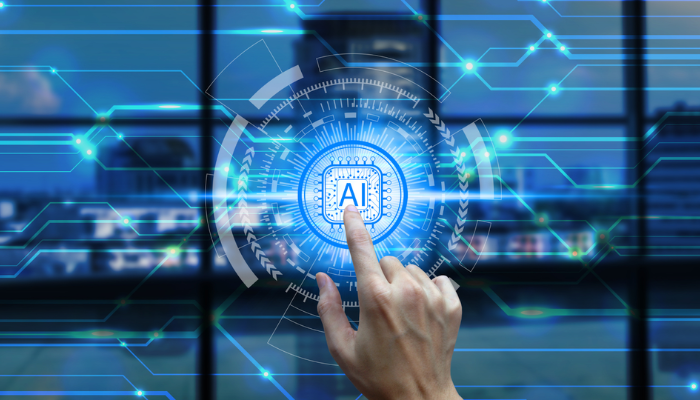You already rely on AI more than you may realize, whether it’s your calendar auto-scheduling meetings, your inbox flagging urgent emails, or your finance software predicting cash flow trends.
These are just a few things that use AI in your everyday routine. For decision-makers, CFOs, and business leaders like you, this shift isn’t just about convenience; it’s a strategic advantage. The US AI market is expanding rapidly, expected to hit $73.98 billion in 2025 and surge to $309.70 billion by 2031, driven by a 26.95% annual growth rate.
In this blog, you’ll find practical, everyday top 10 things that use AI that deliver measurable business outcomes. We’ll cover how AI is used in finance, transportation, healthcare, entertainment, customer service automation, workflow optimization, sales enablement, smart devices, and more.
TL;DR
- AI helps you work smarter, faster, and more efficiently. It turns complex data into real-time insights, automates repetitive tasks, reduces errors, and supports better decision-making across industries.
- In transportation, AI improves route planning, cuts fuel costs, and prevents breakdowns with predictive maintenance.
- In retail and e-commerce, it powers product recommendations, dynamic pricing, and inventory forecasting to drive sales and customer loyalty.
- In personal tech, AI makes smart devices more intuitive, helping you with voice commands, health tracking, and personalized alerts.
- In entertainment, it customizes what your audience sees, enhances gaming, and speeds up media production through automation.
- In customer service, AI chatbots handle routine queries instantly, reduce support costs, and scale 24/7 assistance.
- In social media, it filters harmful content, improves ad targeting, and curates personalized feeds to keep users engaged.
- In education, AI personalizes learning paths, automates grading, and gives you real-time progress insights.
- In healthcare, it supports faster diagnoses, risk prediction, and treatment recommendations, making care more efficient and accurate.
- In finance, AI detects fraud, automates credit scoring, and powers algorithmic trading for better financial decisions.
- In agriculture, it enables smart irrigation, pest detection, and yield forecasting to improve productivity and sustainability.
Why does AI play an important role in 2025?
In 2025, AI isn’t just something you hear about; it’s a real, working tool that helps solve daily business challenges and boost performance in ways that matter. If you’re leading a business or making decisions that impact operations, revenue, or customer experience, here’s why AI helps you:
1. Faster and Smarter Decisions
AI helps you process huge amounts of data in seconds, giving you insights you can actually use. Whether you’re planning sales forecasts, adjusting supply chain strategies, or setting dynamic pricing, AI helps you act faster and more accurately.
2. Better Customer Experiences
AI makes every customer interaction more personal. It recommends products based on shopping behavior, spots suspicious activity in banking to prevent fraud, and even customizes support based on past interactions, leading to stronger trust and loyalty.
3. Increased Efficiency
You can automate time-consuming tasks like invoice approvals, customer support routing, or maintenance scheduling. This cuts down on errors, saves money, and frees up your team to focus on higher-impact work.
4. Stronger Risk Management
AI helps you stay ahead of threats. It constantly scans for fraud, cyber risks, and compliance issues, flagging problems before they grow. That means fewer surprises and less exposure to financial or legal damage.
5. Boosted Productivity
AI tools support your team in simple but powerful ways, like setting up meetings, summarizing long reports, or handling basic questions. This reduces distractions and gives your employees more time for strategic work.
6. Meeting Sustainability Goals
AI supports your ESG efforts by tracking energy use, reducing waste, and improving efficiency. Energy companies use it to optimize usage, while other sectors use it to monitor emissions and report progress.
7. Clearer Communication Across Borders
With AI-powered language tools, it’s easier to translate, transcribe, and interact globally. This removes barriers and helps your business work smoothly across teams and regions.
Struggling to connect patients and doctors digitally, while keeping data secure?
Codewave helps you design and build custom AI-enabled platforms for secure online consultations, diagnostic workflows, and patient monitoring. We bring together cloud, ML, and compliance-driven design to build the right digital health system from the ground up.
You’ve seen why AI matters in 2025. Now it’s time to explore exactly how it’s being used across industries to solve problems and create value.
Top 10 Examples of AI Use Cases
AI is already part of your day, whether you’re using maps, or managing a business. It’s working quietly in the background to make things faster, smarter, and more personal. Here are 10 real-world examples where AI is making a meaningful difference:
1. AI in Transportation
AI is changing how you move goods and manage transportation. Whether you’re running a delivery fleet or coordinating logistics, AI helps you plan smarter routes, cut fuel costs, and avoid delays, giving you better control over daily operations.
Applications:
- Self-Driving Vehicles: Use autonomous trucks or delivery bots for last-mile fulfillment and reduce your reliance on drivers.
- Smart Traffic Signals: Let AI adjust signal timings in real time to reduce idle time and keep your vehicles moving efficiently.
- Route Optimization: Plan faster, fuel-efficient routes using real-time data like traffic, weather, and delivery schedules.
- Predictive Maintenance: Monitor your fleet’s condition and prevent breakdowns before they happen, saving you time and money.
Advantages:
- Faster Deliveries: Avoid traffic jams and meet delivery windows with live route adjustments.
- Lower Costs: Cut fuel expenses, reduce repairs, and extend vehicle lifespan.
- Fewer Accidents: Improve safety with AI-assisted driving and real-time alerts.
- Live Fleet Visibility: Track vehicle status, location, and driver behavior all in one dashboard.
Disadvantages:
- High Initial Costs: Expect upfront spending on AI tools, hardware, and system integration.
- Safety and Legal Issues: Make sure your team follows proper protocols and local laws, especially with autonomous vehicles.
- Data Security Risks: Protect sensitive location and driver data from breaches or misuse.
- Regulatory Compliance: Stay updated on evolving transportation regulations that may impact deployment.
Overcome challenges:
- Run a Pilot: Test AI tools on a small fleet before rolling them out across your business.
- Create Safety Protocols: Set clear rules for human overrides and emergency responses.
- Secure Your Data: Work with vendors that offer encrypted systems and strong data protection.
- Talk to Regulators: Build early partnerships with local agencies to stay compliant and avoid disruptions.
2. AI in Retail and Online Shopping
If you’re in retail or eCommerce, AI can help you deliver smarter shopping experiences, manage stock more accurately, and increase revenue with less manual effort. By using AI tools, you’re not just keeping up, you’re staying ahead of shifting customer expectations and market demands.
Applications:
- Product Recommendations: AI studies what your customers view, search, and buy, then shows them relevant products. This leads to more conversions without extra marketing spend.
- Automated Customer Service: Chatbots and virtual agents handle common queries instantly, from tracking orders to suggesting alternatives, reducing your support load and speeding up service.
- Inventory Optimization: AI predicts which products will sell, in what quantity, and when. This helps you avoid overstocking or stockouts, improving both cash flow and customer satisfaction.
- Visual Search: Shoppers can upload photos to find similar products in your catalog. It shortens the path to purchase and enhances discovery, especially on mobile.
Advantages:
- Higher Sales and Engagement: Personalized product suggestions encourage larger carts and more frequent visits.
- Better Inventory Turnover: With smarter demand forecasting, you buy only what you’ll sell, nothing more, nothing less.
- Stronger Customer Experience: AI helps you deliver quick, relevant, and seamless shopping, online or in-store.
- Fewer Returns: Better recommendations and sizing tools reduce mismatched purchases.
- Improved Loyalty: When customers feel understood and supported, they come back more often and spend more.
Disadvantages:
- Data Privacy Concerns: You’re handling personal shopping data. Without clear policies, you risk losing customer trust or facing compliance issues.
- Over-Reliance on Algorithms: If you lean too much on automation, you may miss trends or ignore valuable customer feedback that AI can’t catch.
- Biased Recommendations: AI learns from your existing data. If the data has gaps or skewed patterns, your results will too.
- Integration Challenges: Adding AI tools to your existing systems, POS, CRM, and eCommerce platforms can be complex and time-consuming if not planned well.
Overcome challenges:
- Be Transparent About Data Use: Let customers know what data you collect and how you use it. This builds trust and keeps you compliant with privacy laws like GDPR or CCPA.
- Audit Your AI Regularly: Check how your recommendation engines, pricing tools, and chatbots are performing and adjust if needed to avoid bias or missed opportunities.
- Balance AI with Human Input: Keep your team involved. Use AI for speed and scale, but let humans step in when empathy, creativity, or judgment is needed.
- Invest in Training: Help your staff understand how AI tools work and how to use insights to make better merchandising, marketing, and inventory decisions.
3. AI in Agriculture
AI is helping you solve some of agriculture’s biggest challenges, by increasing efficiency, cutting waste, and improving yield predictions. With the right digital platforms, you can automate tasks, monitor crops in real time, and make faster, data-backed farming decisions.
Applications:
- Smart Irrigation and Water Management: AI tools analyze weather forecasts, soil moisture, and crop type to tell you exactly when and how much to water, saving water and improving plant health.
- Pest and Disease Detection: Using cameras, drones, or sensors, AI identifies early signs of pest damage or disease before they spread, so you can act quickly and protect yields.
- Automated Tractors and Drones: AI-guided equipment applies fertilizers, pesticides, or performs harvesting tasks with precision, cutting costs and minimizing environmental impact.
- Crop Yield Prediction: AI models use satellite data and field conditions to predict output, helping you plan supply chains, manage inventory, and reduce waste.
- Soil and Crop Health Monitoring: Sensors and AI platforms measure nutrient levels and crop growth trends, allowing you to tailor interventions and improve long-term soil health.
Advantages:
- Higher Yields, Higher Profits: AI enables better timing, smarter input use, and faster responses, leading to increased output and stronger returns.
- Less Waste, More Savings: You use fewer chemicals, less water, and optimize labor, cutting unnecessary costs while protecting the environment.
- Faster Problem Detection: Early alerts for weather risks, disease, or nutrient issues allow you to intervene before damage spreads.
- Sustainable Farming: With precise input application and real-time monitoring, AI supports better land use and long-term soil preservation.
- Informed Decisions: AI takes the guesswork out of farming. You base your plans on data, not intuition, boosting consistency and resilience.
Disadvantages:
- High Initial Costs: Equipment, sensors, and software platforms require upfront investment, especially for smaller farms.
- Data Privacy Risks: Shared farming data must be stored and managed securely, especially when using third-party platforms.
- Tech Adoption Barriers: Many farmers lack access to training or support in adopting advanced tools.
- Connectivity Limitations: AI tools often rely on internet access and consistent power, still limited in rural areas.
- Skill Gaps: Operating AI-driven platforms requires basic tech skills that may be lacking in some regions.
Overcome challenges:
- Offer Financial Support: If you’re a policymaker or investor, subsidies or low-interest loans can make adoption easier for small and mid-size farms.
- Invest in Training: Make sure farmers have access to clear, hands-on training programs that simplify AI usage.
- Use Secure, Cloud-Based Platforms: Choose software that encrypts farm data and complies with data-sharing regulations.
- Scale Solutions for All Farm Sizes: Develop tools that work for small plots, not just industrial farms, like mobile-based crop alerts or low-cost sensors.
- Build Rural Infrastructure: Support public-private efforts to expand internet and power access in remote areas so digital farming tools can work reliably.
4. AI in Personal Devices
AI is built into the devices you use every day, smartphones, wearables, and digital assistants. These tools help you stay organized, secure, and informed with minimal effort. Whether you’re managing your schedule or monitoring your health, AI makes these tasks faster and smarter.
Applications:
- Voice Assistants: Tools like Siri, Google Assistant, and Alexa help you set reminders, send messages, or control devices hands-free, improving productivity and accessibility.
- Biometric Authentication: Facial recognition and fingerprint scanning let you unlock devices and apps quickly and securely without passwords.
- Personalized Notifications: AI prioritizes alerts based on your habits, whether it’s muting non-urgent messages during meetings or reminding you of appointments.
Advantages:
- Better Usability: Interactions become quicker and more intuitive, letting you get things done faster.
- Stronger Security: Biometric login adds a layer of protection for apps, wallets, and sensitive information.
- Time Savings: Automating small tasks like text suggestions, reminders, or app shortcuts reduces daily friction.
Disadvantages:
- Battery Usage: AI features can drain your battery faster due to constant processing and background activity.
- Data Privacy Risks: Devices collect sensitive personal data, which must be stored and used responsibly.
- Device Dependence: Relying too much on automation can reduce awareness or critical thinking in daily tasks.
- False Positives: Biometric systems may fail to recognize you in certain lighting or trigger incorrect actions.
Overcome challenges:
- Adjust Device Settings: Limit background tasks and disable features you don’t need to extend battery life.
- Review Privacy Controls: Check app permissions regularly and manage what data is shared with cloud services.
- Use Multi-Factor Security: Combine biometrics with passcodes or 2FA to strengthen protection.
- Educate Users: Make sure your team or family understands how to use AI tools safely and when manual action is better.
5. AI in Entertainment
AI is changing how you create and deliver entertainment. Whether you run a media company, a streaming platform, or a game studio, AI helps you personalize content, speed up production, and better understand your audience. It’s not just about automation, it’s about creating more engaging, tailored experiences at scale.
Applications:
- Content Recommendations: AI tracks user behavior, what they watch, skip, or rewatch, to suggest shows, movies, or songs they’re most likely to enjoy. This increases time spent on your platform and keeps users coming back.
- Automated Editing: You can now use AI tools to auto-edit video clips, add subtitles, or sync music. This saves time and cuts post-production costs without compromising quality.
- Game AI: AI powers non-player characters (NPCs) that adapt to how each gamer plays. This makes the gaming experience more realistic and keeps players engaged longer.
- Music and Video Personalization: Platforms use AI to generate dynamic playlists, adjust audio settings, or auto-create highlight reels based on user preferences, improving overall satisfaction.
Advantages:
- Tailored User Experiences: When users see content that aligns with their interests, they stay longer and engage more deeply with your platform.
- Faster Production: AI tools accelerate editing and content generation, helping your team push out more content in less time.
- Creative Support: You get assistance in brainstorming, scoring, or visualizing content, expanding your creative output.
- Data-Driven Insights: AI uncovers trends in viewing behavior and content performance, helping you make better editorial or licensing decisions.
Disadvantages:
- Filter Bubbles: Over-personalization can limit exposure to diverse content, reducing discovery and viewer satisfaction over time.
- Content Bias: AI trained on skewed data may reinforce biases in recommendations, leading to ethical and reputational risks.
- Over-Personalization: When AI gets too specific, content may feel repetitive or predictable, hurting engagement.
- Copyright Issues: AI-generated content or auto-edits may unknowingly infringe on intellectual property rights.
Overcome challenges:
- Offer a Mix of Content: Include trending, curated, and fresh content alongside personalized recommendations to widen user exposure.
- Monitor for Bias: Regularly audit AI suggestions and adjust algorithms to ensure fairness and diversity.
- Give Users Control: Allow users to reset preferences, hide recommendations, or choose genres manually for better experience control.
- Respect IP Regulations: Ensure AI tools follow copyright rules and avoid reusing protected content without proper licensing.
6. AI in Customer Service
AI helps you deliver faster, more consistent support while reducing service costs. From chatbots to sentiment analysis, AI platforms let you automate routine queries, scale support operations, and understand customer needs in real time, without sacrificing quality.
Applications:
- Chatbots: AI-powered chatbots handle common questions like order status, refund policies, or appointment bookings, instantly, any time of day.
- Automated Ticketing: AI classifies and routes support requests based on priority, topic, and customer history, reducing response times and improving workflow efficiency.
- Sentiment Analysis: AI tools analyze the tone of emails, chats, or reviews to detect frustration or satisfaction, so you can intervene at the right time and improve service.
- Voice Assistants: Virtual agents powered by natural language processing can guide customers through processes like account setup or issue resolution via phone, without waiting for a live agent.
Advantages:
- Faster Support: Customers get answers in seconds, not hours, boosting satisfaction and reducing churn.
- Lower Support Costs: You reduce the need for large support teams by automating high-volume, repetitive inquiries.
- Consistent Service Quality: AI follows predefined logic, ensuring every customer gets accurate and consistent responses.
- Easily Scalable Operations: Whether you’re handling 50 or 5,000 queries a day, AI scales effortlessly without adding headcount.
- Deeper Customer Insights: Real-time analytics give you visibility into customer pain points, common issues, and service gaps, enabling smarter decision-making.
Disadvantages:
- Limited Empathy: AI can miss emotional context in sensitive interactions, which may leave customers feeling unheard.
- Complex Issue Handling: When a customer has a unique or multi-step problem, AI alone may struggle to resolve it.
- Language Barriers: AI tools may not support all languages or dialects effectively, impacting global customer experience.
- User Frustration: Customers may get annoyed if they feel stuck in chatbot loops or can’t reach a real person.
Overcome challenges:
- Enable Seamless Human Handoff: Set up AI to recognize when it can’t help, and instantly transfer the case to a human agent with full context.
- Continuously Train Your AI: Feed updated FAQs, past chat transcripts, and customer scenarios into your AI system to improve accuracy and relevance.
- Support Multiple Languages: Use AI platforms that offer multilingual support or can integrate with translation services to cater to diverse audiences.
- Track Customer Feedback: Use post-chat surveys and sentiment data to refine your AI performance and customer experience strategy.
7. AI in Social Media
If you’re using social media to grow your brand, run ads, or manage a digital community, AI plays a key role in how you engage users, promote content, and keep platforms safe. It helps you personalize feeds, detect harmful content, and target the right audience, automatically and at scale.
Applications:
- Content Moderation: AI scans posts, comments, and videos to flag harmful or inappropriate content, reducing the need for manual review.
- Personalized Feeds: It learns what users like and adjusts content delivery to keep them engaged with your posts longer.
- Ad Targeting: AI segments your audience and optimizes who sees your ads, improving click-through and conversion rates.
- Fake News Detection: Platforms use AI to flag misleading content, helping protect your brand’s presence from misinformation.
Advantages:
- Safer User Experience: Harmful content is filtered out quickly, protecting your brand and users.
- Better Reach and Engagement: Personalized delivery means your content reaches those most likely to interact with it.
- Improved Ad ROI: Smarter targeting reduces waste and boosts campaign efficiency.
- Scalable Monitoring: AI reviews thousands of posts instantly, keeping content quality high.
Disadvantages:
- Bias in Algorithms: Poor data can lead to unfair filtering or skewed recommendations.
- Privacy Risks: Misuse of personal data in targeting can lead to compliance issues.
- Misinformation Gaps: AI might miss subtle false claims or satire.
- Echo Chambers: Over-targeting can limit content diversity and discovery.
Overcome challenges:
- Promote Algorithm Transparency: Let users and stakeholders know how content is ranked or moderated. This builds trust and shows accountability.
- Partner With Fact-Checkers: Work with verified agencies or use platforms that integrate third-party fact-checking to ensure credible content visibility.
- Give Users Feed Controls: Allow users to customize their feed or opt out of certain algorithmic recommendations, increasing satisfaction and reducing bias.
- Audit AI Systems Regularly: Review your platform’s AI performance to catch bias, ensure fairness, and adapt to new risks.
8. AI in Education & Learning
AI helps you make education more personalized, efficient, and accessible. Whether you’re managing a school system, building an edtech platform, or supporting corporate training, AI tools allow you to deliver content that adapts to individual learners while reducing manual tasks for educators.
Applications:
- Adaptive Learning Platforms: These platforms adjust lessons in real time based on how a learner performs. If someone struggles with a topic, the system slows down and offers more support, making sure no one gets left behind.
- Automated Grading: AI can grade multiple-choice, short answers, and even essays. This frees up time for educators to focus on teaching and mentoring rather than paperwork.
- Virtual Tutors: AI-powered tutors answer common questions, explain concepts, and guide students through exercises, offering support outside classroom hours.
- Personalized Study Plans: AI recommends learning paths based on strengths, weaknesses, and goals. This keeps students engaged and focused, improving learning outcomes.
Advantages:
- Individualized Learning: You give each student a tailored experience, helping them learn at their own pace with better retention.
- Reduced Teacher Workload: Tasks like grading, tracking progress, and scheduling are automated, giving educators more time to plan and teach.
- Early Intervention: AI flags students who are falling behind, so you can offer help before the gap grows.
- Improved Accessibility: Learners with different needs benefit from speech-to-text, visual aids, and flexible pacing, ensuring more inclusive education.
- Data-Driven Insights: You can track progress in real time, identify content gaps, and make fast adjustments to learning strategies.
Disadvantages:
- Equity and Access: Not all learners have equal access to devices or the internet, which can widen the digital divide.
- Over-Reliance on Technology: Relying solely on AI may ignore emotional, social, or critical thinking aspects that human teachers provide.
- Data Privacy Risks: Student data, especially for minors, must be protected with strict privacy controls and compliance with laws like FERPA.
- Concerns About Teacher Roles: Some educators worry AI may replace them, creating resistance to adoption.
Overcome challenges:
- Combine AI With Human Teaching: Use AI to support instruction, not replace it. Let teachers focus on mentorship and creativity while AI handles repetitive tasks.
- Ensure Equal Access: Provide loaner devices, internet support, or offline content to make sure every learner benefits equally.
- Secure Student Data: Work with vendors who offer encryption, access controls, and full transparency in how data is stored and used.
- Train Your Educators: Equip teachers with the skills to use AI tools effectively, interpret insights, and integrate tech meaningfully into their curriculum.
9. AI in Healthcare
AI helps you deliver faster, safer, and more personalized medical care. From diagnostics to treatment planning, AI tools improve decision-making, reduce administrative load, and enhance overall efficiency in healthcare delivery.
Applications:
- Diagnostic Imaging: AI analyzes X-rays, MRIs, and CT scans to detect conditions like tumors or fractures more quickly and accurately than manual review.
- Virtual Health Agents: Chatbots and voice assistants handle basic patient queries, schedule appointments, and provide symptom checks, reducing wait times and improving accessibility.
- Predictive Analytics: AI models forecast patient risks, readmission chances, or disease progression using historical data, helping you intervene earlier.
- Drug Discovery: AI speeds up research by identifying compounds, predicting drug interactions, and narrowing down viable treatment candidates faster than traditional methods.
Advantages:
- Faster Diagnoses: Automating image review and data analysis cuts delays and speeds up treatment.
- Reduced Errors: AI catches patterns that human eyes might miss, leading to fewer diagnostic mistakes.
- Personalized Treatment: AI tailors care plans based on patient history, genetics, and response data, improving outcomes.
- Lower Operational Costs: Automation reduces the workload on clinical and admin staff, saving time and resources.
- Better Patient Outcomes: With early risk detection and data-driven decisions, patients receive more accurate and timely care.
Disadvantages:
- Data Privacy Risks: Patient data must be handled with strict controls to meet HIPAA and other regulations.
- High Implementation Costs: Advanced AI tools often require investment in infrastructure, integration, and training.
- Regulatory Complexity: Medical AI solutions must go through lengthy approval processes, delaying deployment.
- Bias in Algorithms: If trained on limited or unbalanced datasets, AI may deliver skewed results, especially across diverse populations.
Overcome challenges:
- Enforce Strong Data Security: Use encryption, access controls, and compliance-ready platforms to protect patient data.
- Follow Regulatory Guidelines: Choose vendors that meet FDA and HIPAA standards and support audit-ready documentation.
- Train on Diverse Data: Ensure AI tools are built with broad, inclusive datasets to minimize bias.
- Validate Models Continuously: Monitor AI performance with real-world data and clinical feedback to maintain accuracy.
10. AI in Finance
AI helps you make faster, safer, and more informed financial decisions. Whether you’re managing risk, improving customer service, or ensuring compliance, AI tools allow your institution to operate more efficiently and competitively.
Applications:
- Fraud Detection: AI tracks patterns in transactions and flags unusual activity in real time, helping you prevent fraud before losses occur.
- Credit Scoring: Instead of relying only on traditional credit metrics, AI evaluates a broader range of data points to assess creditworthiness more accurately and fairly.
- Robo-Advisors: These AI-driven tools provide automated investment advice based on customer goals and risk profiles, making wealth management more scalable and cost-effective.
- Automated Customer Service: AI-powered chatbots and voice systems handle common inquiries, helping you offer 24/7 support while reducing call center load.
Advantages:
- Reduced Fraud: Real-time monitoring and pattern recognition help stop suspicious activity before it becomes a threat.
- Faster Decision-Making: Whether it’s loan approvals or investment adjustments, AI speeds up analysis and execution.
- Lower Operational Costs: Automation reduces the need for manual intervention in customer service, compliance, and reporting.
- Improved Compliance: AI tracks regulatory changes and flags anomalies, helping you stay audit-ready and reduce non-compliance risks.
- Stronger Customer Trust: By delivering faster, more accurate service, you build reliability and transparency, key to customer retention.
Disadvantages:
- Model Bias: If your data is unbalanced, AI may favor or penalize certain profiles unfairly, affecting loan approvals or fraud checks.
- Black-Box Outputs: Some AI decisions are hard to explain, making it difficult to justify outcomes to regulators or clients.
- Security Risks: AI systems process large amounts of sensitive financial data, increasing exposure if not properly secured.
- Regulatory Complexity: Financial AI must comply with strict, evolving rules, slowing implementation and increasing risk if mishandled.
Overcome challenges:
- Ensure Transparency: Use explainable AI models so decisions, like credit denials or fraud alerts, can be traced and justified.
- Run Regular Audits: Test your AI systems for fairness, accuracy, and compliance to catch issues early.
- Strengthen Cybersecurity: Protect customer data and AI infrastructure with advanced encryption, intrusion detection, and access controls.
- Collaborate with Regulators: Stay ahead of changing rules by working closely with financial authorities when deploying AI solutions.
Need to automate irrigation and monitor crop health more accurately?
Codewave helps you build precision farming platforms using AI, IoT, and real-time analytics. From smart water management to AI-driven pest detection, we co-create digital solutions that bring data into the field, literally.
While AI use cases are growing, success depends on how well you implement and scale them. That’s where choosing the right AI partner becomes critical.
Why is Codewave the Right AI Partner for Your Industry?
If you’re looking to integrate AI into your business processes, Codewave helps you move beyond experimentation to actual impact. As a design-thinking-led digital transformation company, Codewave builds smart, scalable AI-powered solutions tailored to your industry’s unique challenges.
With 250+ projects executed across 15 countries, Codewave has the expertise to design digital platforms that make AI practical, actionable, and sustainable for your teams. Take a look at how we’ve transformed ideas into impact. Visit our portfolio to explore real projects.
Here is how Codewave helps you get real value from AI:
1. Education
Codewave helps you deliver hyper-personalized learning at scale. You get:
- E-learning platforms with adaptive tests and progress tracking.
- AI-powered apps for content personalization and psychometric assessments.
- School management systems, mock exams, and mentor-connect platforms;
- Tools to digitize courseware, support social learning, and map learning to employability
Impact: Deliver “in-the-moment” learning that adapts to each learner’s pace and context.
2. Healthcare
Improve diagnosis accuracy, patient engagement, and operational efficiency with:
- AI for scan-based disease recognition and predictive modeling.
- Online consulting platforms and patient-doctor engagement systems.
- Custom diagnostic apps and IoT-driven patient monitoring.
- Blockchain for secure cross-industry collaboration.
Impact: Turn health data into smarter care decisions and boost patient outcomes.
3. Fintech
Streamline financial operations and boost trust with:
- Digital lending workflows and AI-driven credit scoring.
- Robo-advisors, fraud detection tools, and algorithmic trading engines.
- Blockchain-based transaction transparency and personal finance apps.
- Regulatory-compliant integration and spend behavior analytics.
Impact: Reduce fraud, increase speed, and scale financial access with confidence.
4. Energy
Use real-time data to optimize generation, usage, and sustainability with:
- AI-based power generation dashboards and renewable energy monitoring.
- IoT systems for live energy tracking and predictive maintenance.
- Circular economy platforms and blockchain for traceability.
- Apps for consumption pattern insights and efficiency reporting.
Impact: Make your grid smarter, greener, and more responsive with AI-driven intelligence.
5. Insurance
Modernize policy lifecycle and claims processing with:
- Automated AI/ML-led claims settlement and fraud prevention.
- Policy management and exposure risk assessment tools.
- Telematics-based systems and P2P insurance platform development.
- Blockchain for secure, transparent regulatory compliance.
Impact: Reduce paperwork, boost compliance, and offer frictionless policy experiences.
6. Retail
Enhance every customer interaction across channels using:
- AI-driven dynamic pricing and inventory management.
- Beacon-based in-store personalization and smart checkout flows.
- End-to-end app development, demand prediction, and product recommendations.
- Data-driven sales and marketing automation.
Impact: Deliver seamless, consistent experiences both online and offline.
7. Agriculture
Turn precision farming into a reality with:
- AI/ML tools for early crop disease detection and yield prediction.
- Smart irrigation systems, farm robotics, and IoT sensing.
- Livestock monitoring tools and blockchain-based farm-to-table traceability.
- Custom platforms for seed-to-sale, worker management, and sustainability tracking.
Impact: Increase yield, reduce resource waste, and build a traceable, data-led agri supply chain.
8. Transportation
Optimize movement and logistics using:
- AI-driven dynamic pricing engines, fleet tracking, and route prediction.
- Logistics automation, shared transport platforms, and rental services.
- Dockless e-vehicle apps, smart vehicle consoles, and predictive maintenance tools.
Impact: Reduce costs, improve delivery speed, and enhance user experience.
9. Travel & Hospitality
Personalize journeys and streamline operations with:
- Traveler profiling, dynamic pricing, and predictive demand forecasting.
- Online trip planning, smart payments, and GDS integrations.
- Mobile and web platforms for bookings, promotions, and itinerary management.
Impact: Turn your digital ecosystem into a seamless travel experience from discovery to return.
Ready to explore how AI can drive real results for your business?
Book a free consultation with us and discover how Codewave can help you build intelligent, scalable solutions tailored to your industry.
Frequently Asked Questions (FAQs)
1. How does AI know what I like to watch or buy?
AI recommendation engines analyze your past behavior, like searches, purchases, and views, to predict what you’ll like next. Platforms like Netflix and Amazon use this data to personalize suggestions, helping boost user engagement and sales.
2. Are AI tools expensive to use?
Most consumer AI tools are free or low-cost. Virtual assistants and basic chatbots come built-in or as free apps. Business-level AI, like predictive analytics, may require higher investment, but the long-term ROI often outweighs the initial cost through automation, efficiency, and better decision-making.
3. Will AI replace human decision-making completely?
No, AI supports, not replaces, human decision-making. It can analyze data and automate tasks, but final decisions, especially strategic or ethical ones, still need human judgment. The best outcomes come when AI insights are paired with human experience.
Codewave is a UX first design thinking & digital transformation services company, designing & engineering innovative mobile apps, cloud, & edge solutions.







